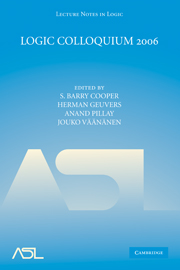Book contents
- Frontmatter
- Contents
- Introduction
- Definability and elementary equivalence in the Ershov difference hierarchy
- A unified approach to algebraic set theory
- Brief introduction to unprovability
- Higher-order abstract syntax in type theory
- An introduction to b-minimality
- The sixth lecture on algorithmic randomness
- The inevitability of logical strength: Strict reverse mathematics
- Applications of logic in algebra: Examples from clone theory
- On finite imaginaries
- Strong minimal covers and a question of Yates: The story so far
- Embeddings into the Turing degrees
- Randomness—beyond Lebesgue measure
- The derived model theorem
- Forcing axioms and cardinal arithmetic
- Hrushovski's amalgamation construction
A unified approach to algebraic set theory
Published online by Cambridge University Press: 28 January 2010
- Frontmatter
- Contents
- Introduction
- Definability and elementary equivalence in the Ershov difference hierarchy
- A unified approach to algebraic set theory
- Brief introduction to unprovability
- Higher-order abstract syntax in type theory
- An introduction to b-minimality
- The sixth lecture on algorithmic randomness
- The inevitability of logical strength: Strict reverse mathematics
- Applications of logic in algebra: Examples from clone theory
- On finite imaginaries
- Strong minimal covers and a question of Yates: The story so far
- Embeddings into the Turing degrees
- Randomness—beyond Lebesgue measure
- The derived model theorem
- Forcing axioms and cardinal arithmetic
- Hrushovski's amalgamation construction
Summary
Introduction. This short paper provides a summary of the tutorial on categorical logic given by the second named author at the Logic Colloquium in Nijmegen. Before we go into the subject matter, we would like to express our thanks to the organisers for an excellent conference, and for offering us the opportunity to present this material.
Categorical logic studies the relation between category theory and logical languages, and provides a very efficient framework in which to treat the syntax and the model theory on an equal footing. For a given theory T formulated in a suitable language, both the theory itself and its models can be viewed as categories with structure, and the fact that the models are models of the theory corresponds to the existence of canonical functors between these categories. This applies to ordinary models of first order theories, but also to more complicated topological models, forcing models, realisability and dialectica interpretations of intuitionistic arithmetic, domain-theoretic models of the λ-calculus, and so on. One of the best worked out examples is that where T extends the theory HHA of higher order Heyting arithmetic [24], which is closely related to the Lawvere-Tierney theory of elementary toposes. Indeed, every elementary topos (always taken with a natural numbers object here) provides a categorical model for HHA, and the theory HHA itself also corresponds to a particular topos, the “free” one, in which the true sentences are the provable ones.
The logic of many particular toposes shares features of independence results in set theory.
- Type
- Chapter
- Information
- Logic Colloquium 2006 , pp. 18 - 37Publisher: Cambridge University PressPrint publication year: 2009
- 2
- Cited by

